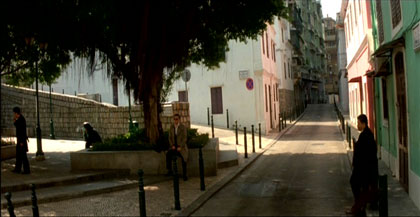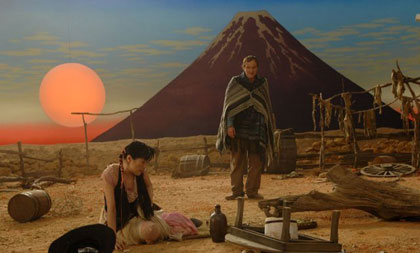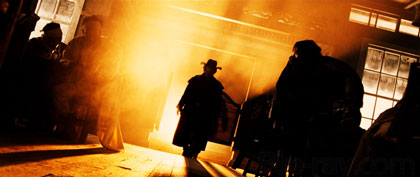Continuous short breakdown on Asian Western films stylistic elements towards the definition of DimSum Westerns.
Hong Kong
As this subject is focused on Hong Kong I start with Johnnie To’s EXILED (2006) which is actually set in Macau.
This choice of location gives the film an interesting Mediterranean touch and flair, far away from the vibrating metropolis of Hong Kong. To, known for constantly applying Western elements to his own style, creates already in the opening scene a typical Leone-like suspense layout. With slow and elegiac camera tracks he moves along the narrow streets and within a small apartment above. The four main protagonists position themselves in front of the house where a scared woman with baby observes the scenery down below. All smoking cigars, no one talks. Now the scenery slowly escalates as a man pulls up the street in a small truck. Entering the house he is being followed by two men from the street, the other two remain in position at the doorstep. Still no dialog! The three men inside the apartment are getting nervous. Each is looking for a good position within the unfurnished room, a shootout is imminent. Next door, the woman is holding on to her baby, not taking cover but watching the scenery. On the street, a police car with the dump corrupt “sheriff” appears. Upstairs the expected wild shooting breaks loose and the two men on the street try to scare the “sheriff” off by demonstrating their shooting skills on an unarmed Red Bull can. This scene of course, as hilarious and typical it might appear for a Hong Kong action film, is a direct homage to Leone´s FOR A FEW DOLLARS MORE (1965) hat shooting scene between Eastwood and Van Cleef. This can-shooting scene becomes a regular running gag throughout EXILED, whenever the cop needs to be kept at bay. However, after all the shooting in the first ten minutes no casualties can be claimed, except a shot can and perforated stone pot. The indoor shoot out is visually quite spectacular solved by To but in the end it turns out all opponents and rivals are old friends, a youth gang from childhood days. Thus, the four dark shooters strip off their trench coats and help hauling up furniture into the empty apartment. Ultimately all having dinner like old pals, as if nothing ever happened, an almost heart-warming scenery. Until this point we had barley dialog between the protagonists.
To undergoes within this first 15 minutes the transition from a classic Italian Western pattern to a classic Hong Kong Jiang-Hu movie. Even though those motives and elements are very strong throughout EXILED, the film does not drift into an awkward homosexual tone as most similar themed films tend to do. However, traditional 1960s Italian Western elements are still strong represented all over the film. The harmonica music played by one of the main protagonists on the ship, the “over-red” blood splatters, the gold transporter ambush on a rural road. Also, the hotel scenes, which recall the so memorable setting of King Hu´s classic DRAGON INN (1967), does not only display To is ranging within his own cinematic roots but also finding direct links between Hu´s classic swords play tales and the wild west colt tales of his Italian colleagues. Both genres do not seem that much apart from each other at the end of the 1960s when it comes to visual storytelling, interior choreography as well as atmospheric density.
Speaking of interiors, EXILED draws a very bleak picture of indoor settings. Most apartments are dirty, decaying, barely furnished and more than simple designed. One can often see behind walls, that are obvious thin wooden stage walls, usually only set into the room to give one protagonist some cover prior to shootouts. Hence, one could interpret those scarce wooden interiors as reminiscence to the shanty towns in Westerns. But one could also read it as symbolic embodiment of the hollow and superficial inner life of most characters. Finally, one might argue the interiors simply represent the absence of private belongings in life of the four main protagonists, except their black bags. They are lonely travelers, constantly on the move with no real home or origin. The latter one would mark, once more, one major element of Italian Western.
Extending his film THE MISSION (1999) to a broader Western approach To shows us the roots of his own cinematic style and even goes further deep into. The suspense build-up and subsequent shootout within the illegal clinic clearly are one of To´s most complex and most delicate choreographed action sequences. Even thought, EXILED is clearly a contemporary film it bears all ingredients and character motives of classic Italian Western films. Hence, it can without doubt be considered as a DimSum Western, simultaneously displaying the wide variety and potential of this genre, which not only orientates itself towards one particular style.
Finally, the overall impression of EXILED remains dull, unfortunately. It appears like a finger exercise for its director and creative team but does not stick out in particular from his Œuvre. The film is a solid work, as usual, but bears a wafer-thin story stretched to long 104 minutes with no real twist or unpredictable move. Ultimately, the focus lies too much on the group of four and their relationship amongst each other, which is a regular theme in Chinese films, but surprisingly all characters within this particular group, just remain two-dimensional.
JAPAN
Before beginning on Takashi Miike´s SUKIYAKI WESTERN DJANGO (2007) I have to admit the fact that I never was a big fan of Miike’s. Apparently his immense influence on contemporary Japanese filmmaking with all those new, up and coming directors trying to imitate and copy his style made me being widely absent from recent Nippon films and rather take refuge with all those 1950s Samurai classics , 60s Yakuza films and bold exploitation of the 70s. Hence, the WESTERN DJANDO did not had a good start with me. However, I was truly eager to see whether Miike could offer a new approach to the exploitive subgenre of Asian Westerns.
The SUKIYAKI WESTERN DJANGO starts with an amazing Tarantino cameo opening sequence that is funny, refreshing and highly entertaining. Recalling the memories of an over-stylized stage play with the artificial set design, one might even briefly think back to Thailand´s great contribution to this genre, TEARS OF THE BLACK TIGER (2000). But then people start talking, in awkward heavy Japanese accent English and things begin to spin out of control. The overall comic-like tone of the film does hold potential, the camera work is gorgeous and the color & light compositions marvelous but Miike´s way of storytelling makes it hard to follow – yes, even hard to watch. Everything is hasty, confusing and lost me after 10 minutes. Things start to get messy and the regular Japanese slapstick insert as well as over-the-top acting does make things even worse.
Thus, I rather concentrate on the visual elements than the story itself, if there ever was one at all. As mixture of Samurai and Western film one can find a whole hawker´s tray of direct references, quotations and own interpretations of famous Italian Westerns. Miike´s cinemascope compositions on the other hand follow widely the traditions of the Samurai classics, especially when it comes to interior arrangements of large groups of actors in a dialog situation.
Apart from that, there are some elements that just do not want to fit right in. All main actors are, typical for contemporary Asian mainstream films, young and good looking guys/girls who miss every character depth. Where are the strong Western-typical faces with deep scars or wrinkles? Faces like Eli Wallach or Lee Van Cleef told already entire stories just by entering the frame. Those faces lived a life of exploitation, violence, booze and to the core shaping traumatic experiences. Those Japanese lads just are hollow figures without any profile. No one is scary or even ambivalent, just too clean, glib and superficial. Miike traded the strongest visual point of Westerns against the favor and commercial market value of a bunch of squawking juvenile Japanese groupies. No one of those “hot” actors is able to portray an angry, deep inside disrupted hero who is on the brink to become a bad guy. Not even to speak of a bad, nasty hero who never was good in the first place.
Another point that seems to disturb the structure of the film is how Miike handles dramatic scenes in which the actual story is being told. He uses occasional flashbacks that are supposed to give the pseudo-story some depth but are just floating by as the river over which the small boy’s parents are being hanged. Those flashbacks are just getting squeezed into a bunch of spectacle outbursts of shooting action. Italian Westerns were building their stories around those flashbacks. This was what gave them literally flesh and blood to emerge from. Here, it is just a brief justification for explosions of violence during the respective following scene that should cover weak acting and low dramatic ability of its actors as well as some story holes. Now, one could argue the same exploitive cover-up of violence can be found at almost all Italian Westerns, which is probably true to a large extent. However, masters of the genre like Leone or Corbucci used right those scenes and sequences to shape their characters, giving them depth and inner disruption by not necessarily letting them play those feelings out but rather by becoming manifest within a complex universe of situations, locations, editing and overall atmosphere. The flashback story was what kept the film running by gradually revealing of motives and the subsequent hero´s destiny. Eventually, flashbacks in SUKIYAKI WESTERN DJANGO appear simply awkward and disturbing for the general story flow. Thus, they do not serve the film but rather lead audience away.
“Yojimbo meets Django” one might self-title the film and indeed SUKIYAKI WESTERN DJANGO is a stunning assimilation of both genres. It is worth watching and clearly shows how Asians can revive those old traditional ways of filmmaking, merging cultural differences by creating an entire new cinematic universe. Even though Miike does not make it easy for audiences to grasp his film it remains an entertaining ride through the past of the Western genre with a possible future light at the end. However, the film remains a straight rip-off from real world cinema classics rather than an intelligent new interpretation. A director with a less distinct cinematic ego might have created a more lasting movie experience.
—–
My next analysis will move on to Korea and Thailand soon. A nice Asian Western Round Up can be found at the Gutter.












